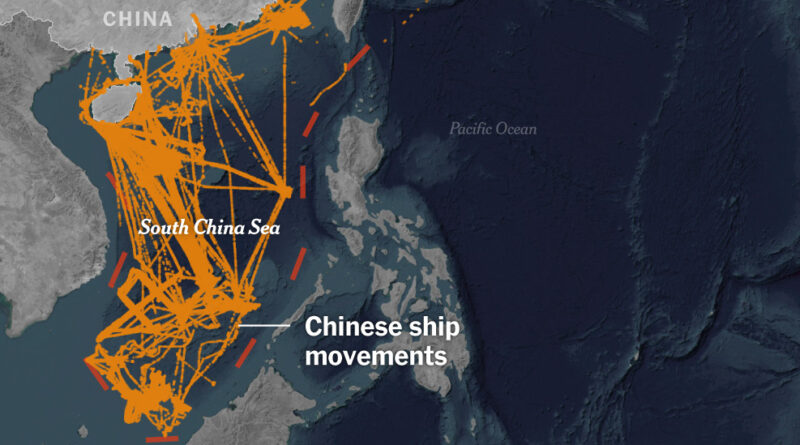Fleets of Force
[ad_1]
Beijing says many of these boats are just fishing. But they bristle with machine guns, rocket-propelled grenades and high-velocity water cannons. They’re here for intimidation.
● Chinese militia and coast guard vessels, Sept.–Oct. 2023
This fleet, built largely with government money, helps China dominate one of the most crucial and disputed waterways in the world: the South China Sea.
China’s territorial claim
Other countries’ Exclusive Economic Zones
Working in tandem with an aggressive coast guard, these militarized fishing boats assert Beijing’s presence more than 1,000 miles from the Chinese mainland.
● Positions of Chinese vessels, May–Oct. 2023
The boats patrol the tiny, disputed Spratly islets. Their reinforced steel hulls make it easy to ram smaller boats. They swarm other countries’ outposts and squat on shoals within sight of foreign coastlines.
● Chinese vessels, Sept.–Oct. 2023
In confrontations with China’s militarized fleet, like this one on Oct. 22, the Philippines’ smaller boats don’t stand a chance. China’s muscle is crucial to its de facto control over the South China Sea.
These fishing boats, most of which don’t actually fish, make up a maritime militia that is upending the rules of the sea. By providing backup to the China Coast Guard and maintaining a constant presence in remote waters—often parking on contested reefs for weeks at a time—they amplify China’s ambitions in the South China Sea.
China’s maritime militia is made up of civilians who on paper hold jobs as commercial fishermen. The blurring of lines is deliberate: China’s leader, Xi Jinping, has stressed the need for civilian-military unity to promote national security.
Such gray zone tactics help China quietly gain command over disputed areas. Beijing has used this method across its vast frontier, from the mountainous borders with South Asia to rocks in the East China Sea. And once China incrementally takes over, a new reality reigns.
That reality is literally inscribed. In May, Chinese coast guard and militia vessels operating in and near Vietnamese waters sailed routes that appeared to trace the first Chinese character in the word “China.” And that word has also been carved on the hills near China’s land borders.
China has already built military bases on multiple Spratly reefs. In the air over the South China Sea, Chinese fighter jets are confronting American military planes with greater frequency. At sea, Chinese vessels have, thus far, avoided a deadly confrontation. But an incident in a remote part of the South China Sea could well spark an international crisis.
Military structures and other facilities are seen on the artificial island built by China on Subi Reef in the Spratlys.
Ezra Acayan/Getty Images
China’s militarization of the South China Sea has sharply raised tensions with the United States. While the U.S. does not claim any territory in the waterway, it is treaty-bound to defend the Philippines, the nation most at odds with China. And should there be a conflict over Taiwan, the presence of Chinese military bases and vessels nearby in the South China Sea could impede the ability of the U.S. and its allies to maneuver.
“With the Chinese in this part of the South China Sea, it’s like fighting water,” said Gregory B. Poling, the director of the Asia Maritime Transparency Initiative at the Center for Strategic and International Studies, or C.S.I.S. “You push them out and then they just come right back.”
An intimidation campaign
Off the coast of the Philippines, a tiny outpost of Philippine marines has borne the brunt of China’s militarization of the South China Sea. Every couple of weeks, Philippine vessels try to resupply the marines stationed at Second Thomas Shoal. And every couple of weeks, the Chinese intervene to assert what they call their “indisputable sovereignty” over the reef.
On Oct. 22, this intimidation was heightened when a large Chinese coast guard ship bumped into a smaller Philippine resupply boat, forcing it to abandon its mission.
1. The approach
3 a.m. local time
This wasn’t the first dangerous encounter this year. In August, a Chinese coast guard ship directed a water cannon at a Philippine resupply vessel. In February, the Philippine coast guard reported that sailors were temporarily blinded by a “military-grade laser” aimed by its Chinese counterpart.
Source: Philippine Coast Guard
Civilians are also caught in the crosshairs. In 2019, a Filipino fishing boat was rammed by a Chinese militia trawler, leaving the fishermen floating in the wreckage for hours before a passing vessel saved them. From Vietnam and Indonesia to the Philippines, fishermen say they can no longer access traditional fishing grounds because of what is in effect a Chinese blockade.
Over the years, Chinese aggression has compelled Southeast Asian nations to suspend oil exploration in the South China Sea, although some efforts have started up again.
A constant, aggressive presence
To project Beijing’s power, militia trawlers have anchored for weeks near China’s island military bases and on reefs that are within other nations’ waters. Rafted side by side, sometimes by the dozens, the boats often lack nets or crews big enough to fish.
Source: Satellite images by Planet Labs and Maxar Technologies
China’s maritime militia, by numbers and by reach, has no challenger in the South China Sea. In fact, the fleet is far bigger than what’s needed to fish these waters, according to an analysis by C.S.I.S.
On any given day, satellites identify hundreds of Chinese militia boats in the South China Sea and at nearby ports.
Hundreds of militia boats can be observed daily
Daily count of boats seen from satellite at key locations
Funding from the Chinese government keeps the militia afloat.
Dozens of Chinese militia boats are constructed by state-owned companies. These vessels are designed for confrontation, with steel hulls, long silhouettes and an array of weaponry. Smaller, wooden fishing boats find themselves overwhelmed.
A reinforced Chinese militia boat.
Jes Aznar for The New York Times
Other militia boats are recruited from the commercial fishing fleet. But because the most generous Chinese government subsidies go to the biggest vessels, even these commercial trawlers are larger than most of the Philippine coast guard’s fleet.
An emboldened coast guard
If the purpose of the maritime militia is to crowd contested waters, the Chinese coast guard is also redefining its role, veering dangerously close to a military stance.
Radiating out from the military bases China constructed by pouring sand on underwater Spratly reefs, such as Mischief and Subi, China’s coast guard roams the South China Sea. Chinese ships have fired water cannons at Philippine and Vietnamese boats. They have tangled with the Indonesian Coast Guard.
And in a week in May, Chinese coast guard ships, together with maritime militia boats, churned through waters off the coast of Vietnam in the exact same, curious routing. The paths the vessels took created the character 中, which is the first character in the Chinese word for “China.” The character was sprawled over a 350-mile stretch, equivalent to the distance from New York City to Canada.
China’s coast guard has expanded the range of its patrols
Note: Data runs from Nov. 1 through Oct. 31 for each year.
The Chinese coast guard is now the world’s largest, and its range and presence in the South China Sea have increased dramatically in recent years. Stocked with retired navy corvettes and newer vessels that are longer than most U.S. Navy destroyers, the Chinese coast guard boasts ships that dwarf those of other nations.
Jes Aznar for The New York Times
With an emboldened Chinese coast guard flanked by a powerful maritime militia, there are fears growing of a showdown in the South China Sea.
“Every single reef has some fraction of a percent of a chance,” Mr. Poling said, “to be the next international flashpoint.”
[ad_2]
Source link



